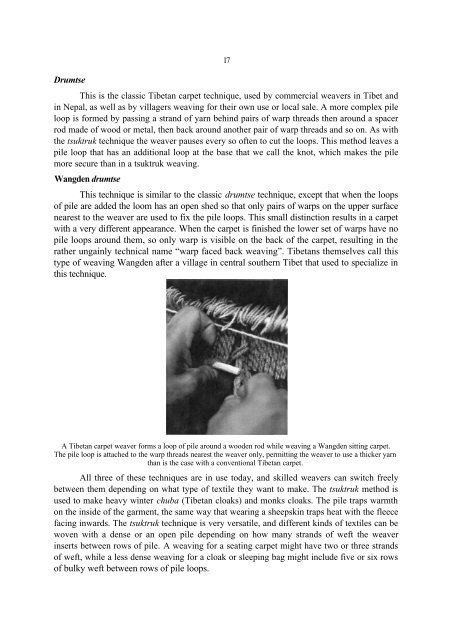download - OATG. Oxford Asian Textile Group
download - OATG. Oxford Asian Textile Group
download - OATG. Oxford Asian Textile Group
- No tags were found...
You also want an ePaper? Increase the reach of your titles
YUMPU automatically turns print PDFs into web optimized ePapers that Google loves.
Drumtse17This is the classic Tibetan carpet technique, used by commercial weavers in Tibet andin Nepal, as well as by villagers weaving for their own use or local sale. A more complex pileloop is formed by passing a strand of yarn behind pairs of warp threads then around a spacerrod made of wood or metal, then back around another pair of warp threads and so on. As withthe tsuktruk technique the weaver pauses every so often to cut the loops. This method leaves apile loop that has an additional loop at the base that we call the knot, which makes the pilemore secure than in a tsuktruk weaving.Wangden drumtseThis technique is similar to the classic drumtse technique, except that when the loopsof pile are added the loom has an open shed so that only pairs of warps on the upper surfacenearest to the weaver are used to fix the pile loops. This small distinction results in a carpetwith a very different appearance. When the carpet is finished the lower set of warps have nopile loops around them, so only warp is visible on the back of the carpet, resulting in therather ungainly technical name “warp faced back weaving”. Tibetans themselves call thistype of weaving Wangden after a village in central southern Tibet that used to specialize inthis technique.A Tibetan carpet weaver forms a loop of pile around a wooden rod while weaving a Wangden sitting carpet.The pile loop is attached to the warp threads nearest the weaver only, permitting the weaver to use a thicker yarnthan is the case with a conventional Tibetan carpet.All three of these techniques are in use today, and skilled weavers can switch freelybetween them depending on what type of textile they want to make. The tsuktruk method isused to make heavy winter chuba (Tibetan cloaks) and monks cloaks. The pile traps warmthon the inside of the garment, the same way that wearing a sheepskin traps heat with the fleecefacing inwards. The tsuktruk technique is very versatile, and different kinds of textiles can bewoven with a dense or an open pile depending on how many strands of weft the weaverinserts between rows of pile. A weaving for a seating carpet might have two or three strandsof weft, while a less dense weaving for a cloak or sleeping bag might include five or six rowsof bulky weft between rows of pile loops.
















